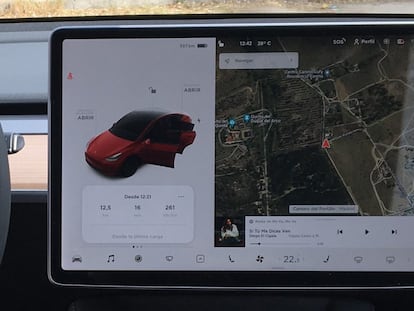Nuevo León’s lack of budget and delays in environmental permits endanger the construction of a Tesla plant in Mexico
After announcing an investment of nearly $5 billion to build a factory in northern Mexico, Elon Musk’s company is facing unexpected delays. This would impact its plan to put its new model on the market in 2025

Time is running out for electric vehicle giant Tesla. After announcing an investment of almost $5 billion in March to build a plant in northern Mexico, Elon Musk’s company is facing unexpected delays. This would impact its plan to put its new model on the market in 2025, so the project is “at risk,” according to an analysis by the Commerce, Economics, and Business Analysis Laboratory of the National Autonomous University of Mexico (UNAM).
According to Ignacio Martínez, academic researcher and director of the Laboratory (known by its acronym, LACEN), Tesla’s plans have been affected on two fronts. Firstly, the construction of rainwater, road, and railway infrastructure that the Governor of Nuevo León Samuel García had promised has not started, and it is not known where the public money will come from to pay for it. The second is that the environmental permits necessary to begin construction, which are granted at the municipal, state, and federal levels, are taking longer than expected.
Given the presidential aspirations of García, whose party announced that it will announce its candidate in January, Tesla set its sights on the federal budget presented by the Ministry of Finance on September 8. Nuevo León turned out to be one of the preferred states, with an increase of almost two billion pesos ($112 million) in programmed spending, the second-highest increase after the country’s capital. But there is no budget item for the infrastructure projects promised to Tesla. “If investment to start the infrastructure before 2024, that is, in the next two months, is put in place, [the Tesla plant] will come to fruition. If not, it is put at risk,” says Martínez.
García can secure funds from other sources or projects to finance the infrastructure, but he would have to do it soon. In March, Tesla announced that its new, more affordable model would hit the market by 2025. If Tesla wanted the Mexico plant to be the one that produced the new cars, construction on the rainwater, road, and rail infrastructure had to begin this year, Martínez calculates. This has not happened.
“Based on this gigafactory, Tesla needs to determine the time it takes to produce the vehicles to be able to compete in the automotive industry’s new range [the new electromobility scheme], starting in 2025,″ but “the infrastructure times in Nuevo León and the permits do not run parallel to Tesla’s logistical times,” he points out.
On Thursday, Tesla Business Development Director Rohan Patel indirectly responded to speculation that the company would not move forward with the project in Mexico, saying on social media: “We will continue to make progress with the local, state, and federal governments, and we are very appreciative of their efforts to enable the permits and sustainable infrastructure necessary.”
The rumors were flying not only because of the obvious delay in construction, but also due to a couple of paragraphs in Musk’s biography, published in September, in which the author stated that he had regretted choosing Mexico since it would be impossible to move their engineers to live there. For their part, Tesla suppliers who had been asked to move to Santa Catarina received urgent notification that the opening of the plant would be delayed, according to the newspaper Reforma.
“What we have at this moment is an investment project, not a productive investment,” explains Martínez. He goes on to say that although the project has been announced, there is no commitment to see it through, and as such the company could still leave. Until now, the owners of the land that the plant will occupy have already received payment for the site. Considering the resources that Tesla has (with a market value of $820 billion), it could absorb a loss due to the partial purchase of the land without it representing a financial problem.
Sign up for our weekly newsletter to get more English-language news coverage from EL PAÍS USA Edition
Tu suscripción se está usando en otro dispositivo
¿Quieres añadir otro usuario a tu suscripción?
Si continúas leyendo en este dispositivo, no se podrá leer en el otro.
FlechaTu suscripción se está usando en otro dispositivo y solo puedes acceder a EL PAÍS desde un dispositivo a la vez.
Si quieres compartir tu cuenta, cambia tu suscripción a la modalidad Premium, así podrás añadir otro usuario. Cada uno accederá con su propia cuenta de email, lo que os permitirá personalizar vuestra experiencia en EL PAÍS.
¿Tienes una suscripción de empresa? Accede aquí para contratar más cuentas.
En el caso de no saber quién está usando tu cuenta, te recomendamos cambiar tu contraseña aquí.
Si decides continuar compartiendo tu cuenta, este mensaje se mostrará en tu dispositivo y en el de la otra persona que está usando tu cuenta de forma indefinida, afectando a tu experiencia de lectura. Puedes consultar aquí los términos y condiciones de la suscripción digital.
More information
Archived In
Últimas noticias
Most viewed
- Sinaloa Cartel war is taking its toll on Los Chapitos
- Reinhard Genzel, Nobel laureate in physics: ‘One-minute videos will never give you the truth’
- Oona Chaplin: ‘I told James Cameron that I was living in a treehouse and starting a permaculture project with a friend’
- Why the price of coffee has skyrocketed: from Brazilian plantations to specialty coffee houses
- David King, chemist: ‘There are scientists studying how to cool the planet; nobody should stop these experiments from happening’











































